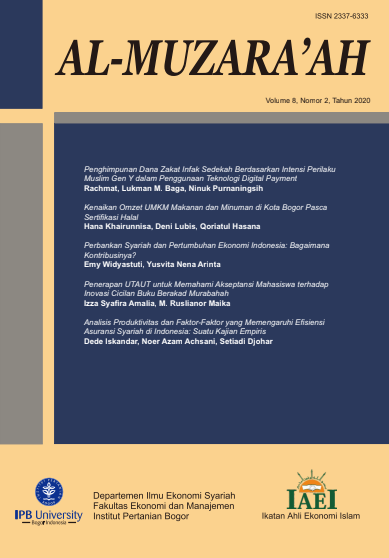Perbankan Syariah dan Pertumbuhan Ekonomi Indonesia: Bagaimana Kontribusinya?
Main Article Content
Abstract
Islamic banking takes part in the Indonesian economic and financial system which contributes to the dynamics of eeconomic growth. The number of Islamic banks in Indonesia, through its market share, is still quite small, namely 5.95% in 2019 of the total national banking market share. One of the main activities of Islamic banking is channeling financing through financing based on the type of use and business category. This study aims to determine the short-term and long-term contribution of Islamic banking to Indonesia's economic growth using the Vector Error Correction Model (VECM) method. The data used in this study are quarterly secondary data of real Gross Domestic Product (GDP) and financing based on the use and category of Indonesian Islamic banking business types, which consist of working capital financing, investment financing and consumption financing. The results showed that in the short and long term, the variable consumption financing had a significant negative effect on Indonesia's economic growth.
Article Details
Section
Author(s) who published in this journal agree to following terms:
- Authors understand and agree that copyright of manuscripts published are held by Al-Muzara'ah. The statement to release the copyright to Al-Muzara'ah is stated in Copyright Transfer Agreement (CTA) form.
- Copyright encompass exclusive rights to reproduce, to distribute, and to sell any part of the journal articles in all form and media.
This work is licensed under a Creative Commons Attribution-ShareAlike 4.0 International License (CC BY-SA) where Authors and Readers can copy and redistribute the material in any medium or format, as well as remix, transform, and build upon the material for any purpose, but they must give appropriate credit (cite to the article or content), provide a link to the license, and indicate if changes were made. If you remix, transform, or build upon the material, you must distribute your contributions under the same license as the original.
References
Abedifar, P., Hasan, I. & Tarazi, A. (2016). Finance-growth nexus and dual-banking systems: Relative importance of Islamic banks. Journal of Economic Behavior & Organization, 132, 198-215.
Afandi, M. A. & Amin, M. (2019). Islamic bank financing and its effects on economic growth: A cross province analysis. Signifikan: Jurnal Ilmu Ekonomi, 8(2), 243-250.
Anwar, S. M., Junaidi, J., Salju, S., Wicaksono, R., & Mispiyanti, M. (2020). Islamic bank contribution to Indonesian economic growth. International Journal of Islamic and Middle Eastern Finance and Management, 13(3), 519–532.
[BPS] Badan Pusat Statistik. (2019). Pendapatan Nasional Indonesia [Internet]. [diunduh 2020 Sep 5]. Tersedia pada: https://www.bps.go.id/publication/2020/06/12/7fe8d749c43bad46b1601662/Pendapatan-nasional-indonesia-2015-2019.html.
[BPS] Badan Pusat Statistik. (2019). Seri PDP Indonesia 2010 [Internet]. [diunduh 2020 Sep 5]. Tersedia pada: https://www.bps.go.id/dynamictable/2016/02/09/1135/-seri-2010-pdb-triwulanan-atas-dasar-harga-konstan-2010-menurut-lapangan-usaha-miliar-rupiah-2010-2013.html.
El Ayyubi, S., Anggraeni, L., & Mahiswari, A. D. (2018). Pengaruh bank syariah terhadap pertumbuhan ekonomi di Indonesia. Al-Muzara'ah, 5(2), 88-106.
Farahani, Y. G., & Dastan, M. (2013). Analysis of Islamic banks' financing and economic growth: a panel cointegration approach. International Journal of Islamic and Middle Eastern Finance and Management, 6(2), 156-172.
Fasih, F. (2012). Inclusive growth in India through Islamic banking. Procedia-Social and Behavioral Sciences, 37, 97-110.
Hachicha, N. & Amar, A. B. (2015). Does Islamic bank financing contribute to economic growth? The Malaysian case. International Journal of Islamic and Middle Eastern Finance and Management.
He, Q., & Xu, B. (2019). Determinants of economic growth: a varying-coefficient path identification approach. Journal of Business Research, 101, 811-818.
Imam, P., & Kpodar, K. (2016). Islamic banking: Good for growth? Economic Modelling, 59, 387–401.
Lebdaoui, H. & Wild, J. (2016). Islamic banking presence and economic growth in Southeast Asia. International Journal of Islamic and Middle Eastern Finance and Management, 9(4), 551–569.
Lee, J. W., & Hong, K. (2012). Economic growth in Asia: Determinants and prospects. Japan and the World Economy, 24(2), 101–113.
Mahzalena, Y., & Juliansyah, H. (2019). Pengaruh inflasi, pengeluaran pemerintah dan ekspor terhadap pertumbuhan ekonomi di Indonesia. Jurnal Ekonomi Regional Unimal, 2(1), 37-50.
Majid, M. S. A. & Kassim, S. H. (2015). Assessing the contribution of Islamic finance to economic growth. Journal of Islamic Accounting and Business Research, 6(2), 292–310.
[OJK] Otoritas Jasa Keuangan. (2019). Roadmap Pengembangan Keuangan Syariah [Internet]. [diunduh pada 2020 Sep 5]. Tersedia pada: https://www.ojk.go.id/id/kanal/syariah/berita-dan-kegiatan/publikasi/Documents/Pages/Roadmap-Pengembangan-Keuangan-Syariah-Indonesia-2017-2019/Roadmap%202017-2019(1).pdf.
[OJK] Otoritas Jasa Keuangan. (2019). Statistik Perbankan Syariah 2019 [Internet]. [diunduh pada 2020 Sep 5]. Tersedia pada: https://www.ojk.go.id/id/kanal/syariah/data-dan-statistik/statistik-perbankan-syariah/Documents/Pages/Statistik-Perbankan-Syariah---Desember-2019/SPS%20D esember%202019.pdf.
Rizvi, S. A. R., Narayan, P. K., Sakti, A., & Syarifuddin, F. (2019). Role of Islamic banks in Indonesian banking industry: an empirical exploration. Pacific Basin Finance Journal, February, 62.
Rusliani, H. (2018). Ekonomi syari’ah solusi dalam menghadapi krisis moneter (perbandingan Malaysia–Indonesia). Al-Amwal: Jurnal Ekonomi dan Perbankan Syari'ah, 10(2), 199-214.
Sarwer, M. S., Ramzan, M., & Ahmad, W. (2013). Does islamic banking system contributes to economy development. Global Journal of Management and Business Research, 13(2).
Sulistiana, I. (2017). Model Vector Auto Regression (VAR) and Vector Error Correction Model (VECM) approach for inflation relations analysis, Gross Regional Domestic Product (GDP), world tin price, BI rate and rupiah exchange rate. Integrated Journal of Business and Economics, 1(2), 17–32.
Tabash, M. I., & Dhankar, R. S. (2014). Islamic banking and economic growth: An empirical evidence from Qatar. Journal of Applied Economics and Business, 2(1), 51-67.
Yusof, R. M., & Bahlous, M. (2013). Islamic banking and economic growth in GCC & East Asia countries. Journal of Islamic Accounting and Business Research, 4(2), 151-172.

